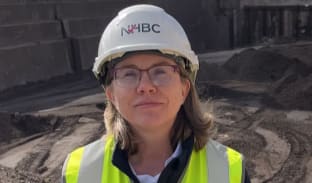NHBC’s Land Quality Service (LQS) team began working with Vistry Group early in the development of the site at Longbridge in Birmingham. Alongside Rodgers Leask Limited (RLE) as Principal Designer and McAuliffe Group as Principal Contractor, NHBC were able to support the vision of transforming the area into a vibrant residential community.
Background
Previously part of Europe’s largest car manufacturing factory and the ‘spiritual home of the Mini’, the site in Longbridge closed in 2005. Now, twenty years later, Vistry Group acquired the site in 2024 with the aim of creating new homes in this disused area.
The former Austin works area of the wider Longbridge site is set to become a residential space providing 695 much-needed new homes in the form of a mix of one and two-bedroom apartments and larger two, three and four-bedroom family houses.
As Adam Bills, Technical Director at Vistry North Midlands explained “Brownfield sites are essential for building development. They do require expertise and input from developers, but they present excellent opportunities to create homes in places people are already living and working, with the advantages of excellent transport links and established amenities already in place.”
Making a derelict site suitable for new homes
A large brownfield site in an area facing a shortage of affordable homes, this development faced its fair share of technical challenges and requisite regeneration work including:
Removing basements, grouting WWII tunnels and infilling
The site included two WWII tunnels dug into sandstone in 1939. Serving as air raid shelters and underground workspaces for moving aircraft parts between the factories at Longbridge, the tunnels extended 1200m at depths of up to 25m below ground level. The tunnels posed risks, so stabilisation was needed to prevent any future collapse or excessive settlement.

The solution:
Key actions were taken across the site to address these issues including:
- Buried tanks and hotspots needed to undergo excavation for treatment or disposal and materials were sampled at a rate of one per 250m³ to prove suitability for re-use.
- A 600mm clean cover will be applied in all soft landscaped areas.
- Groundwater monitoring was conducted before and after earthworks to confirm no release of contaminants.
- Post-earthworks ground gas monitoring is to be completed to evaluate if there could be a reduction in gas protection measures through betterment of ground conditions.
Earthworks
The site was covered by hardstanding and underlain by significant Made Ground, as well as an extensive basement network up to 5m below ground.

The solution:
RLE developed an earthworks strategy considering NHBC Standards Chapter 4.6 – Engineered Fill. This is important as it sets out NHBC requirements for developing on filled ground. The scope of work to be carried out by McAuliffe included the following:
- Excavation of Made Ground to 2m below proposed levels or to natural geology.
- Removal of hardstanding and in-ground obstructions.
- Crushing of all rubble containing concrete, masonry and brick to produce Class 6F2 material suitable for re-use.
- Removal, assessment, treatment (if required) and validation of contaminated material.
- Re-profile, re-engineer and test the fill across the site to achieve the desired formation level and compaction to create a development platform suitable for house building.
In addition, to support sustainability Vistry Group looked to reuse as much site-generated material as possible. Initial estimates by McAuliffe indicated that 260,000m3 of material would be generated, while the planned fill volume was 160,000m3. However, fill volumes were expected to increase due to the discovery of new basements beneath the slabs which resulted in less going offsite.
The benefits of the NHBC Land Quality Service
By engaging with the LQS team early in the development process, Vistry Group was able to minimise any unforeseen problems and mitigate risks on this complex site.
A Stage 1 and 2 Land Quality Certificate was issued for the whole of the Longbridge development in November 2024. Remedial earthworks are currently ongoing, and LQS will issue a series of Stage 3 certificates to mirror the delivery of housebuilding phases.
All photos are courtesy of McAuliffe and Rodgers Leask.



